
A video about Gabriel Dumont, a teacher's guide for Grades 3-5 and some illustrations can be found here.
- Subject:
- Social Studies
- Material Type:
- Reading
- Provider:
- Gabriel Dumont Institute
- Date Added:
- 10/03/2023

A video about Gabriel Dumont, a teacher's guide for Grades 3-5 and some illustrations can be found here.

A digital collection of advertisements for runaway and captured slaves in the period before the American Civil War. In addition, there are historical documents related to slavery. Gives the option of browsing or doing a detailed search. Includes some teaching materials.

Grades 3-4. Students are introduced to the idea of electrical energy. They learn about the relationships between charge, voltage, current and resistance. They discover that electrical energy is the form of energy that powers most of their household appliances and toys. In the associated activities, students learn how a circuit works and test materials to see if they conduct electricity. Building upon a general understanding of electrical energy, they design their own potato power experiment. In two literacy activities, students learn about the electrical power grid and blackouts.
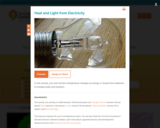
Discover how electricity can be converted into other forms of energy such as light and heat. Connect resistors and holiday light bulbs to simple circuits and monitor the temperature over time. Investigate the differences in temperature between the circuit with the resistor and the circuit using the bulb.

Students learn about the underlying engineering principals in the inner workings of a simple household object -- the faucet. Students use the basic concepts of simple machines, force and fluid flow to describe the path of water through a simple faucet. Lastly, they translate this knowledge into thinking about how different designs of faucets also use these same concepts.
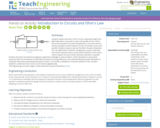
Students explore the basics of DC circuits, analyzing the light from light bulbs when connected in series and parallel circuits. Ohm's law and the equation for power dissipated by a circuit are the two primary equations used to explore circuits connected in series and parallel. Students measure and see the effect of power dissipation from the light bulbs. Kirchhoff's voltage law is used to show how two resistor elements add in series, while Kirchhoff's current law is used to explain how two resistor elements add when in parallel. Students also learn how electrical engineers apply this knowledge to solve problems. Power dissipation is particularly important with the introduction of LED bulbs and claims of energy efficiency, and understanding how power dissipation is calculated helps when evaluating these types of claims. This activity is designed to introduce students to the concepts needed to understand how circuits can be reduced algebraically.

Learn the basics of circuits with this video. Video will define current and resistance to explain how electrons flow to create electricity. [11:39]
Khan Academy learning modules include a Community space where users can ask questions and seek help from community members. Educators should consult with their Technology administrators to determine the use of Khan Academy learning modules in their classroom. Please review materials from external sites before sharing with students.
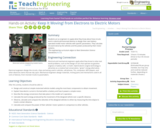
Students act as engineers to apply what they know about how circuits work in electrical/motorized devices to design their own battery-operated model motor vehicles with specific paramaters. They calculate the work done by the vehicles and the power produced by their motor systems.

This exhibition by National Portrait Gallery titled "Let Your Motto Be Resistance" presents photographs documenting notable African Americans and their contributions to American culture. The gallery of portraits offers an impressive selection of images of each individual accompanied by a short biography.
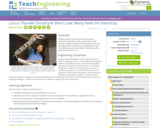
Students explore the composition and practical application of parallel circuitry, compared to series circuitry. Students design and build parallel circuits and investigate their characteristics, and apply Ohm's law.

Students learn how to find the maximum power point (MPP) of a photovoltaic (PV) panel in order to optimize its efficiency at creating solar power. They also learn about real-world applications and technologies that use this technique, as well as Ohm's law and the power equation, which govern a PV panel's ability to produce power.
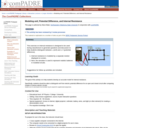
Through class discussion and think-pair-share questions, this activity helps students come to understand the difference between emf and potential difference in electrical circuits. These concepts are broached within the context of internal resistance of batteries.

Students learn about the concepts of fairness and justice and people who worked to overcome injustice, while developing informational reading strategies for reading narrative nonfiction texts.

Examine how fuel use affects the mass of different planes during flight. This lesson teaches students how to determine the per person fuel cost of a transatlantic flight for seven airplanes, and display the results on a bar graph. Three student handouts are available in PDFs for printing.

At this site from Georgia State University Ohm's law is stated in words and using equations. A JavaScript form allows for multiple practice problems with instant feedback and reinforcement. Kirchoff's current law is stated and illustrated for both a series and a parallel circuit.
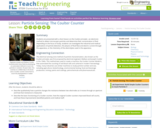
Students are presented with a short lesson on the Coulter principle—an electronic method to detect microscopic particles and determine their concentration in fluid. Depending on the focus of study, students can investigate the industrial and medical applications of particle detection, the physics of fluid flow and electric current through the apparatus, or the chemistry of the electrolytes used in the apparatus.
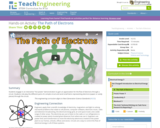
Students engage in an interactive "hot potato" demonstration to gain an appreciation for the flow of electrons through a circuit. Students role play the different parts of a simple circuit and send small items representing electrons (paper or candy pieces) through the circuit.

An interactive simulation that teaches about Ohm's Law, circuits, and current by observing how adjusting the voltage and resistance changes current according to Ohm's Law. This simulation can either be downloaded or played online and includes handouts, lesson plans, and additional materials.

An interactive simulation that teaches about resistivity, resistance, and circuits by observing how changes in resistivity, length, and area affect resistance in a wire. This simulation can either be downloaded or played online and includes handouts, lesson plans, and additional materials.

Explore the resistance of a wire by altering its resistivity, length, and area to see what the effects are.